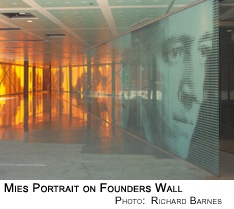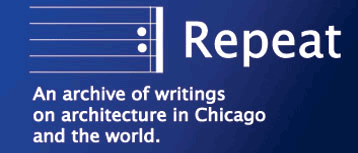|
|
 I.
Introduction I.
Introduction
II.
Mies van der Rohe and the Creation
of a New
Architecture on the
IIT campus
III.
About Rem Koolhaas
IV. Rem Koolhaas's
IIT McCormick Tribune
Campus Center
V. An Interview
with
Rem
Koolhaas
A
trim six foot five,
Koolhaas has the bearing of an ascetic, but he's a star of Elvis proportions. His globe-trotting started early. He was born
in 1944 in Rotterdam, when the city was still in ruins from German firebombing.
When he was eight his father, a prominent Dutch writer, film critic, and
film school director, was offered a cultural post in Indonesia. Koolhaas's
four years there sparked a continuing fascination with Asia that would
culminate in his 2001 book Great
Leap Forward, a dazzling study of the explosive development in
China's Pearl River Delta region after it was designated a free-trade
zone.
Koolhaas attended film school and co-wrote The White Slave, a 1969
Dutch film noir, and later wrote an unproduced script for American soft-porn
king Russ Meyer. He also worked as a journalist in the Hague. In 1968 he decided to study architecture in London.
In 1972 a Harkness Fellowship brought Koolhaas and his wife, architect
and painter Madelon Vriesendorp, to New York. He was fascinated by the dynamics
of the city and how it stood apart from the urban-design trend toward "dedensifying" cities, tearing down entire blocks to create
open malls and plazas. Manhattan seemed to thrive on what Koolhaas called the "culture
of congestion" in his sensational 1978 book, Delirious
New York: A Retroactive Manifesto for Manhattan, an irreverent fusion of scholarship,
design, and polemics; its dust jacket was a painting by Vriesendorp depicting the Empire State and Chrysler buildings lounging postcoitally on a bed.
In 1975 Koolhaas-along with Vriesendorp and Greek architect Elia
Zhengelis and his wife, Zoe-founded the Office for Metropolitan Architecture, which was dedicated to finding "new synergies" between architecture
and contemporary culture. Their first decade produced a series of striking,
but losing, submissions to high-profile architectural competitions. It wasn't until 1987, with his design of the Netherlands
Dance Theatre, that Koolhaas got to construct his first building. That was followed by a string of increasingly ambitious projects, and in 2000 he won the Pritzker
Prize, often referred to as the Nobel Prize for architecture. His second landmark book-the 1,300-page, eight-pound S,M,L,XL
-summarizes OMA's work and thought through 1995. It includes definitions,
quotes, anecdotes, and observations from an insanely wide range of sources-Mies
and Frank Lloyd Wright, Nietzsche and Voltaire, Darwin and David Byrne,
Pontius Pilate and Norman Bates.
"I'm a wunderkind and proud of it," Koolhaas proclaimed in February
1998, when he came to IIT to lecture after winning the competition for the student center. "I've been a wunderkind for a very long time."
Koolhaas's essay Miestakes includes a mysterious, murkily lit 1986
photo of himself cleaning the floor of the just-completed reconstruction of Mies's Barcelona Pavilion. Except for his hand, Koolhaas is visible only
as a shadow projected on the wall.
Asked what inspires his love of Mies, he
replies, "Ironically, I don't really know. Maybe Mies is the largest possible opposite and therefore
the most attractive. Apart from that, there is simply aesthetics and a deep liking for disappearance rather than minimalism"-likely a reference
to the effort of an architect to become invisible in his own work.
Koolhaas rejects Mies's bedrock belief that architecture arises out of reason and order. During the February 1998 lecture he called on people
to "accept the world in all its sloppiness and somehow make that into
a culture." And he contended that the time 50 years ago when Mies was building the 860-880
Lake Shore Drive apartment towers was one of "extreme innocence, when you could make people happy with relatively little. We
need more complexity now, and, I think, our design provides it."
 Intro
| Mies | Koolhaas
|
Intro
| Mies | Koolhaas
|  | Campus Center | Koolhaas
Interview
| Campus Center | Koolhaas
Interview 
lynnbecker@lynnbecker.com
© Copyright
2003-2004 Lynn Becker All
rights reserved.
|



